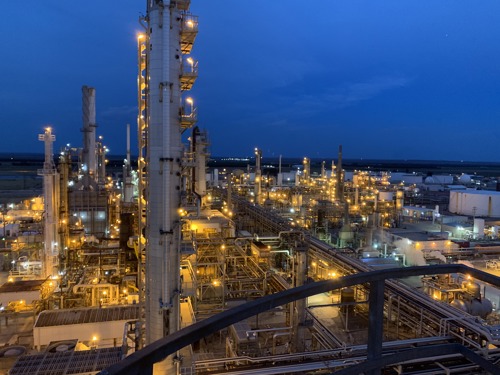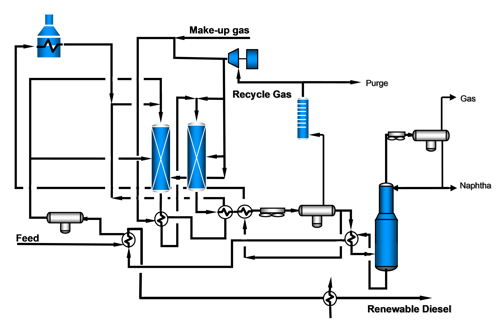2021 AFPM Annual Meeting Virtual Edition—Renewable fuel production: An EPC perspective
Yasmine McColl, Director, Business Development, KP Engineering, LP
Anyone working in the downstream sector has likely heard the new buzzword in the space: renewable diesel. As an engineering, procurement and construction (EPC) firm serving the downstream industry throughout its 75-year history, KP Engineering has seen many new process technologies take our industry by storm. Over the years, we have adjusted to meet our customer and market needs and have continued to help our customers benefit from seamless project execution strategies. Today, we find ourselves at the forefront of this industry transition to green energy and are among a single-digit number of EPC contractors designing and building a renewable diesel unit (RDU) in Artesia, New Mexico (FIG. 1).
It is not enough to be economic—it must be green. Our industry is changing and evolving. Many shareholders of major oil and gas companies want to see companies investing in cleaner and greener ways to produce energy products, but these projects must make economic sense.

FIG. 1. A site in Artesia, New Mexico where a grassroots RDU is planned.
California’s LCFS (Low-Carbon Fuel Standard) gives refiners economic credit for producing low-carbon fuels. The standard is designed to decrease the net carbon intensity of the transportation fuel pool and to provide a range of low-carbon and renewable alternatives that reduce petroleum dependency and achieve air quality benefits.1 California has been the most aggressive state in this regard, and with a stated goal of replacing petroleum diesel with renewable diesel by 2030, the state gives refineries and energy producers tax credits for producing renewable products. Other states, such as Oregon and Washington, have followed suit and several more states are predicted to adopt a similar standard.
What does this mean for our refinery clients? It is no secret that the refining industry has been heavily impacted by the shifting domestic fuels market. Demand growth for certain refined products was slow before the shutdowns associated with the COVID-19 pandemic. Smaller refineries, in particular, have struggled with the recent collapse in oil prices, shrinking growth and margins for gasoline and other refined products, and the discontinuation of waivers for renewable identification numbers (RINs) credit exceptions.
A renewable diesel unit addition could provide just the boost needed for a refinery that has suffered in this volatile market. Many of our key clients are investigating spending their CAPEX budgets on renewable diesel, renewable jet fuel and related projects.
The renewable diesel market. With only five renewable diesel plants now in operation in the U.S., the market is primed with opportunity for RDU production. According to the U.S. Department of Energy, these five plants have a combined capacity of nearly 400 MMgal/yr. Production is expected to grow in the coming years due to expansions at existing plants and the construction of new plants.
While the U.S. Energy Information Administration (EIA) does not report renewable diesel production, the U.S. Environmental Protection Agency (EPA) reports Renewable Fuel Standard (RFS) RIN data, which indicates that the U.S. consumed more than 900 MMgal in 2019. Nearly all domestically produced and imported renewable diesel is used in California due to economic benefits under the LCFS2; but with states like Oregon, Washington and New York—as well as Canada—following suit, now is the ideal time to adjust operations to follow the market need for renewable diesel.
What is the difference between renewable diesel and bio-diesel? Renewable diesel is defined as diesel meeting all specifications of typical petroleum diesel, but which is produced by hydrotreating non-petroleum materials such as vegetable oils, animal fats, or used cooking oil (UCO). Renewable diesel is completely interchangeable with petroleum diesel and is completely compatible on a 100% basis in existing diesel engines.
Renewable diesel is different than bio-diesel, which is produced from many of the same animal and vegetable oils as renewable diesel, but by a different process called trans-esterification (FIG. 2). This process adds oxygen to these oils—when blended with petroleum diesel, its emissions characteristics are improved. Bio-diesel contains certain properties that make it inconvenient to store and limit its content in diesel fuels to 5%–20% due to its incompatibility with existing diesel engines. Due to these disadvantages, its production in the U.S. has been limited.

FIG. 2. Renewable diesel basic process flow diagram.
Renewable diesel is considered “low carbon” for two reasons. First, because the vegetable oils are less of a chemical mixture than crude oil, the diesel produced from them is more homogeneous and generally has a higher cetane number than petroleum diesel. Cetane number is a measure of how efficiently a diesel engine can generate power with that fuel. As a result, more energy is derived from less fuel, reducing emissions per unit amount of energy. In addition, renewable diesel contains essentially zero sulfur and other impurities found in petroleum diesel.
Second, in so-called “lifecycle emissions” calculations, credit is given to the growing process of the vegetable itself, which, of course, consumes carbon dioxide (CO2). Considering all factors, renewable diesel has a carbon intensity (defined as the grams of CO2 emitted per megajoule of energy produced upon combustion) of about 30 vs. approximately 102 for petroleum diesel produced today.
The renewable diesel process. In a conventional refinery, certain crude fractions are hydrotreated as part of the process to produce diesel fuel. While the final diesel product is identical, the processes and technologies used to produce renewable diesel products are different. As renewable diesel is made from non-petroleum renewable resources, such as vegetable oils and animal fats, it requires more hydrogen to saturate these oils. This leads us to expect a boost in hydrogen production in upcoming years as more renewable diesel plants are built.
Getting started. These basic steps can help owner-operators get started:
- Begin with a study—Conducting a feasibility study identifies the opportunity before beginning the project. KP Engineering has completed feasibility studies for some of the largest U.S. refiners. Our experience means a shortened learning curve for our customers.
- Lay out the plan—Whether a unit needs to be repurposed to process a variety of renewable feedstocks or the entire refinery needs to be overhauled, engineering and technology will be of the utmost importance to ensure the project is completed safely, efficiently and cost-effectively. Partnering with the right EPC company will bring relevant experience to these types of projects. KP Engineering is already executing a renewable diesel project for a major public U.S. refiner, which lends us superior process and project execution perspective. Since we are not a technology provider, we can assess the technology solutions and give unbiased feedback on the technology selection.
- Build into reality—If a grassroots approach is chosen or the plant needs to be revamped as an RDU, milestones and associated costs must be managed to ensure deadlines are met at competitive prices that keep the bottom line intact. KP Engineering’s flexible EPC contracting strategies afford the most cost-effective method of project execution.
Literature Cited:
1 https://ww2.arb.ca.gov/our-work/programs/low-carbon-fuel-standard
2 https://afdc.energy.gov/fuels/emerging_hydrocarbon.html
About the author:
Yasmine McColl is the Director of Business Development at KP Engineering. Ms. McColl has 19 years of strategic sales experience in various energy downstream industries. Since 2002, she has held numerous technical and commercial roles for operation, catalyst, specialty chemical and technology licensing providers. Ms. McColl holds a BS degree in chemical engineering and an MBA from the University of Houston.







Comments